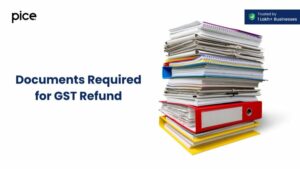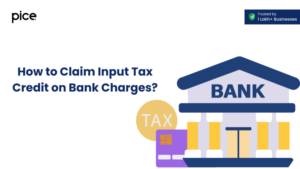What is Input Tax Credit and How to Check Input Tax Credit in GST Portal?
- 20 Sep 24
- 10 mins
What is Input Tax Credit and How to Check Input Tax Credit in GST Portal?
Key Takeaways
- Input Tax Credit (ITC) reduces the GST liability by allowing businesses to offset taxes paid on purchases against taxes collected on sales.
- To claim ITC under GST, businesses must file monthly returns, verify supplier details, and meet specific eligibility criteria like possessing a valid tax invoice.
- ITC is ineligible for certain expenses, including personal consumption, construction services, and specific categories like motor vehicles and catering unless used for specific taxable supplies.
- The deadline to claim ITC is either the filing date of the annual return or the September return of the following financial year, whichever comes first.
- You can easily check available ITC on the GST portal by accessing the electronic credit ledger and following a few simple steps.
Input tax credit is a type of GST paid by purchasers that reduces the GST liability. It can help a registered person reduce the GST payable amount on the outward supply of goods and services by the input credit amount.
Learn what input tax credit is in detail and the steps to claim it. Further, learn how to check input tax credit in the GST portal through a step-by-step guide to make the process easy and convenient for you.
Definition of Input Tax Credit (ITC)
Input Tax Credit means the GST that a registered person pays on goods and services purchased for the furtherance of business. It reduces the tax liability of the registered person by reducing the output tax paid amount.
For instance, if the input tax paid is ₹500 on goods or services purchased and the output tax amount payable is ₹750, then the net tax payable is ₹250. Thus, the tax liability of the registered person reduces.
Steps to Claim ITC under GST
Knowing the steps to claim input tax credit can help you claim seamlessly. Here are the steps to claim ITC under GST:
Step 1: Declare your input tax credit details and output tax liability by filing monthly returns in form GSTR-3B.
Step 2: Ensure you verify the input tax credits with that of the supplier.
Step 3: In the case there are discrepancies, ensure you reconcile them in the next monthly return.
Step 4: In the case where there is any penalty or interest charged, ensure you pay them along with the excess input tax credit.
Following the rules helps you increase cash flow and profitability ensuring compliance with the GST norms.
Types of Taxes in GST
There are three core types of taxes in GST. Here are the three types of taxes for you:
State GST: The state government levies State Goods and Services Tax (SGST) on intra-state transactions. SGST subsumes several taxes such as entertainment tax, luxury tax, and purchase tax. In Indian union territories like Chandigarh, Union Territory Goods and Services Tax (UGST) replaces SGST.
💡 If you want to pay your GST with Credit Card, then download Pice Business Payment App. Pice is the one stop app for all paying all your business expenses.
Central GST: The central government levies Central Goods and Services Tax (CGST) for intrastate transactions. CGST is imposed by the government in addition to SGST or UGST wherein the central and state governments share the revenue. It replaced excise duty in the new GST regime.
For instance, if you are a Delhi-based dealer and sell goods to another dealer in the same state, it is an intrastate transaction. Both CGST & SGST will apply to the transaction at a GST or tax rate of 18% wherein 9% will be CGST and the other 9% will be SGST. Thus, both the state and central will share the revenue generated from the sale of goods in Delhi.
Integrated GST: The central government levies Integrated Goods and Services Tax (IGST) on inter-state transactions. IGST applies to imports and exports wherein the central and the state share the taxes charged. This tax helps you avail input tax credit mechanism, thereby ensuring a complete supply chain solution.
Union Territory GST: UTGST applies to the supply of goods and services within union territories in India. The government levies UTGST in addition to CGST for intra-union territory transactions. Further, the central government collects UTGST and shares it with the union territories. The same tax rate and exemption rate applies to UTGST as SGST.
As common state GST cannot be applied to union territories, the GST council introduced UTGST for the union territories in India. However, SGST can be applied in UT like New Delhi and Puducherry as exceptions to the law.
Eligibility for Claiming ITC under GST

There are certain eligibility criteria for claiming input tax credit under GST. The following are the eligibility criteria:
- Possession of Tax Invoice and Invoice Details: The taxpayer must possess a valid tax invoice or debit note to be eligible for ITC claims. In such a case the taxpayer can claim credits on purchases based on invoices.
- Receipt of Goods or Services: In the case where billing and shipping addresses are different, the registered person should have received the goods to claim ITC.
- Actual Payment of Tax: The supplier must have paid the taxes in order to claim ITC under GST. Suppliers can receive claims after-tax payments to the government.
- Furnishing Return: The registered person needs to file returns in order to claim ITC under GST.
- Lot-based Eligibility: If you receive inputs in lots or instalments, then you can claim ITC after receiving the last instalment or lot.
- Timely Payment to Supplier: The recipient must pay the value of goods or services followed by the tax to the supplier within 180 days of invoice issuance. In the case when the recipient fails to pay, the credit amount gets added to output liability with interest as per the invoice rules. Further, partial payments allow proportionate credit.
Conditions for Claiming ITC under GST
Section 16 of the CGST Act presents the conditions for claiming ITC under GST. Here are the conditions that you need to know:
- The registered person should be eligible by adhering to all the eligibility criteria above. For instance, possession of tax invoice and invoice details, receipt of actual goods and services, actual payment of taxes, furnishing of return with the right form for filing return, lot-based eligibility and timely payment to supplier are the criteria that the registered person should meet.
- ITC will not be allowed if you claim depreciation on the tax component of capital goods under the Income Tax Act 1961.
- If you claim ITC after the due date of filing GST returns it will not be allowed as per the GST laws.
- Common ITC for taxable supplies or exempt supplies or for use for non-business or personal purposes must be separated.
- Items enlisted under Section 17(5) of the GST Act are excluded from ITC claims for a registered person.
Time Limit for Claiming ITC under GST
You can claim ITC on the earlier of the two dates as mentioned below:
- The last date of filing a financial year’s annual return or
- The due date for filing monthly returns in month of September of the next financial year
For instance, if as a registered person, you want to claim ITC for the financial year 2022-23, you must proceed before the last date of filing annual returns in 2022-2023 or filing monthly returns for September 2023.
Items Excluded from ITC Eligibility
There are certain items excluded from ITC eligibility. Here is the list of items on which you cannot claim ITC:
- Motor vehicles and conveyance; however if these are used for transportation of passengers or goods and for training purposes they are included.
- Food and beverages, outdoor catering services, health services, beauty treatment, cosmetic and plastic surgery unless you use these as taxable composite or mixed supply.
- Club membership fees, health and fitness centre
- A rental cab, life insurance, and health insurance unless these are mandatory for employers to provide as outward supply that is taxable, taxable composite or mixed supply
- Employee travel benefits for vacation and home travel concession
- Works contract services when supplied for immovable property construction
- Goods or services received for the construction of immovable property, other than machinery and plants
- Services and goods on which you pay taxes under the composite scheme
- Goods and services that you use for personal consumption
- Lost, stolen, written off, destroyed, disposed of goods, free samples and gifts
- Tax paid for short payment, excessive refund, suppression, misdeclaration, fraud, and confiscation
- Goods or services that you use to make exempt supplies
Checking Available ITC on the GST Portal
You can check or download the available ITC on the GST portal. If you are still thinking about how to check input tax credit in the GST portal, here are the steps to help you out:
Step 1: Visit the unified portal of GST and log in using your user credentials
Step 2: Navigate to the ‘services ledger’ option and then ‘electronic credit ledger’.
Step 3: The page allows you to view the details of the credit ledger. However, if the amount is negative, you cannot use it to pay your liabilities.
Step 4: Select the dates on the page to view the transactions
Step 5: You can view the electronic credit ledger details.
Step 6: You can save the electronic credit ledger in PDF or EXCEL format based on the option you select on the screen
Step 7: Click on the description displayed on the screen to view whether the tax officer blocked or unblocked the credit amount.
Step 8: You can close the window on completion by clicking on ‘ok’.
The Bottom Line
As you know how to check input tax credit in the GST portal, you can easily check ITC before claiming it following the right claim process. This can help you experience a seamless claim journey while claiming input tax credits. Further, you can follow the steps to claim ITC and get your GST claims without any hassle.
 By
By 
















